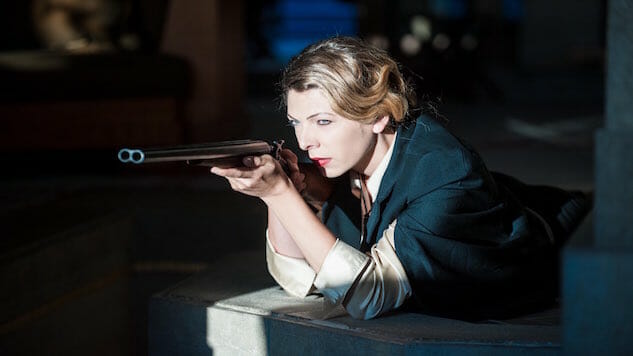
Theatre director Kate Jopson isn’t totally sure she believes in fate. But her newest production, a staging of Fefu and Her Friends at Los Angeles’ Hollyhock House at Barnsdall Art Park, has her wondering. The story of an unconventional rich woman, inviting her friends for a weekend-long philharmonic planning session, staged in the house where an actual woman of means lived and plotted ways to support the arts? It’s strange, right?
“It’s interesting because I’m not a very spiritual person,” agrees Tunde Skovran, who plays the role of the titular eccentric. “Before every show I basically have a little conversation with Barnsdall. That’s how I warm up. I’m greeting her, telling her this show is for you. Thank you very much. Her vision was to create a cultural complex here in the Barnsdall park. And that never happened. We are fulfilling her dream after eighty years. It’s interesting. Every time I have this discussion with her, very short, I’m asking for a sign. And I get it. I’m talking about a black cat in the show, a black cat showed up once. Then a black bird showed up. Then tonight I’m asking for a sign and it’s a moth.”
After witnessing the production, which takes place throughout the entire Frank Lloyd Wright-designed house, it’s hard not to believe in a magical spark. Written by María Irene Fornés, the production features poetic monologues and fevered dreams. Eloquent exchanges about the state of love, education, and life. Vulgar jokes and food throwing. In one memorable stretch the audience is broken up into five-person groups and treated to a series of scenes performed in spaces so small the fourth wall feels paper thin. Even though it was first written in 1977 the subjects that tackle feel modern, and the women feel realistically complex.
“We wanted to do something multinational because our production company’s mission is to bring European American artists together and foster collaborations between many culture groups and nations,” explains Julia Ubrankovics. She plays the wheelchair-bound Julia, who over the course of two hours becomes a subject of curiosity, horror, and line of redemption for many of the characters. “We saw this play and Kate brought it to us it was like, this is it. Fornés is Cuban, she’s an immigrant, and she’s a feminist. It’s eight women, all different. It’s about liberation and freedom.”
At its center, Fefu and Her Friends is play about everything…even if it seems to pride itself more on the questions it raises than the answers it provides. Through their interactions the women are forced to confront the nature or mortality. The line between love and sex. The value of education. And the dangerous of class divisions. The director and her actors all agree—it doesn’t matter what the viewer takes away from the smorgasbord of themes, as long as they’re forced to think and feel.
“I think there’s two parts of this play that I really related to,” Jopson muses. “Julia’s scene that’s in the little room in there where it’s such a dark view of society, but it’s the thing that I always fear—that we’re not really in control of our own fates and that culture and society have created so much for us. How much can we really get out of? I did A Doll’s House for my thesis in graduate school, and that was a big part. I hated that play and then suddenly in my late 20s I realized we become dolls. It’s very hard as a woman to not get beaten in by society. To not compromise and change in ways to the point where your sixteen-year-old self wouldn’t recognize you at thirty. There’s way where it’s not as overt as crippled physically, but I think that’s why Fornés made it physical. It’s what happens inside you. Gradually it starts wearing away until you realize you’re succumbing to these things that you never imagined you would.”
But for every dark point, the writer and crew offer up a counterpoint. For Jopson that came in the speech of the free-spirited character Emma, who encourages the women to cut loose.
“There’s this idea where you can strip away until you find yourself and what that is,” she continues. “So both of those. The darkest part of how I view humanity and then the most hopeful of what we can be. I love that they’re both in the same play.”
It’s that belief in the good that everyone involved with Fefu and Her Friends holds close to their hearts. Why not? They staged a play that no one usually touches, in a historical landmark that’s never hosted a cultural event quite like this. And to hear them tell it, they’re already dreaming of mounting similarly ambitious productions.
“We creating a winning situation for everyone,” says Ubrankovics. “Everyone involved was a winner in this. It was amazing because Hollyhock and the city of Los Angeles are perfect partners. And it’s been fantastic to work with Kate since we’ve been working with her and she had our trust. It was good for the house because we brought life in. It’s good for the city because now it’s open to the public. It all came together in a way that’s good for everyone. It’s a very powerful platform.”